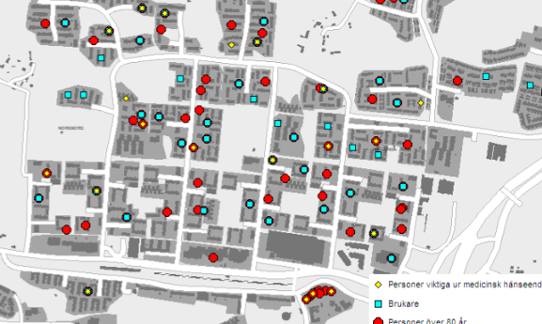In 2010 a heatwave in Botkyrka caused problems at a residential home for older people. The residents felt unwell in the heat and the staff found it difficult to work in the heat and give them their best care. Sweden does not experience the same level of heat as people living further south, but we are less able to adapt to high temperatures which means that we are vulnerable to heatwaves. Research shows that the daily mortality rate increases by 10% if the temperature reaches 27°C or more for 3 days in a row, and that it increases by a further 10% if the temperature reaches 30°C or more for 3 days in a row.

Work on heatwaves in Botkyrka
The work to reduce the effects of heatwaves on health in Botkyrka started when staff took part in a project as part of the Climatools research programme. It involved creating a tool to map how many people in the municipality were particularly vulnerable in the event of heatwaves and where they lived. The project was carried out by a group consisting of municipality staff and experts from the Swedish Defence Research Agency (FOI).
The municipality staff used the knowledge acquired in the research project to start working at the same time in increasing the level of preparedness for heatwaves in the municipality. Awareness of heatwaves was enhanced within health and social care, and heatwave checklists were introduced. To ensure preparedness in the long term, heatwaves are amongst the items addressed in the municipality’s regular inspections.
Measures
After the summer of 2010
- Identifying vulnerable groups
- Knowledge dissemination among the staff working with health and social care
- Preparedness to act according to checklists during a heatwave
- Purchase fans for the retirement homes
- Regular inspections of preparedness
- Ability to call on extra staff to the retirement homes in the event of a heatwave.
- Ensure that the future retirement homes and preschools are built with the capacity to provide the necessary cooling in the event of heatwaves.
During and after the summer of 2018
- The elderly with home care and in the residential homes are visited more frequently during a heatwave.
- The managers are more visible among the different workplaces to ensure that the staff is able to work in the heat and look after the elderly.
- An additional management group has been installed for heatwaves.
- The plan is to provide comfort cooling in one health and social care accommodation every year. This is done in a way so that the costs of energy consumption do not increase.
Financing
Increased preparedness for heatwaves now forms an integral part of the municipality’s risk management work, and has been undertaken as part of regular activities with no additional funding. The main cost was the time of the four people from the municipality who worked most on the Climatools project. It lasted 1 ½ years and was the equivalent of around 3 months of full-time work for each person during that time.
Adaptation pays off
Botkyrka municipality have been better equipped for the heatwave 2018, as they raised the issue already 2010/2011.
More examples of climate adaptation
This is one of many examples of climate adaptation. There are more in the collection of ideas being built up by the Swedish National Knowledge Centre for Climate Change Adaptation at the Swedish Meteorological and Hydrological Institute (SMHI). The collection of examples has the aim of sharing experiences and providing ideas to everyone who works with climate adaptation. Examples describe concrete measures and challenges in several subject areas. They show how different actors have worked to adapt their activities to the climate changes that are already being noticed today and those that we cannot prevent in the future.